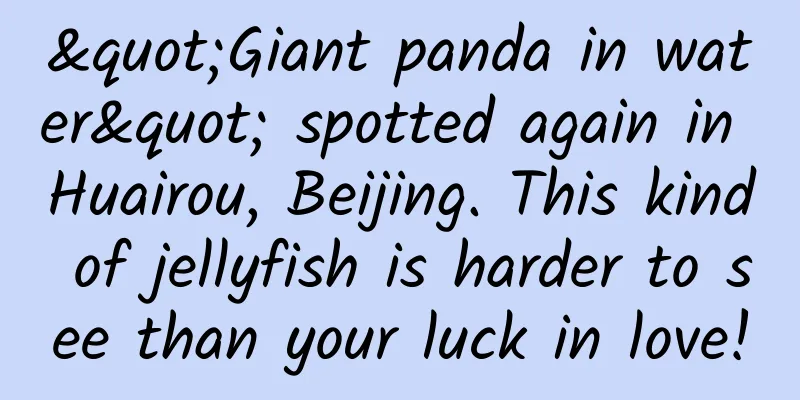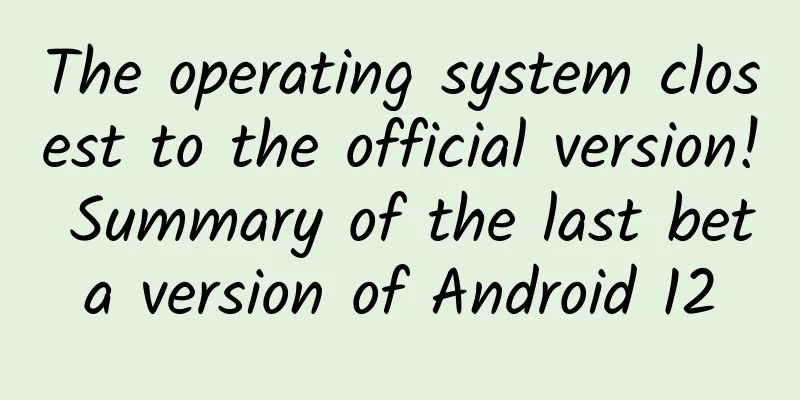"Giant panda in water" spotted again in Huairou, Beijing. This kind of jellyfish is harder to see than your luck in love!

|
Recently, the news that the "giant panda in the water" moon jellyfish reappeared in Beijing's Huairou Reservoir has become a hot search. In recent years, the comprehensive index of water ecological health of Huairou Reservoir has increased year by year, and the biodiversity of various types of aquatic species has gradually increased. It ranked first in the water ecological monitoring and health evaluation of 23 large and medium-sized reservoirs in the city in 2021. Today, let us get to know the peach jellyfish~ Image source: Beijing TV 1 “Peach Blossom Fish” is not a fish? In fact, the peach blossom fish recorded in ancient books does not refer to only one kind/type of fish, but usually includes two types of aquatic animals: the first type often refers to several small carp fish with similar morphology and habits, such as broad-finned bream (liè) and horse-mouthed fish. In the third year of the Yongzheng reign of the Qing Dynasty, it was recorded in the "Zhi Fang Dian Jia Bu Hui Kao": "Peach Blossom Fish is small in shape, delicious, and available in five colors. It can be found in flooded areas within March." Interestingly, in the Jingzhou volume of the same book, there is a record about peach blossom fish, but the description is quite different: "Peach blossom fish are shaped like elm pods, of different sizes, wriggling in the water, and when they move, they contract and expand, like a person gathering his fingers to expand and contract, without knowing how to avoid people. The same is true when taken out of the water. When you look at it, it is just like a pinch of saliva, soft and shapeless." The object described in this text is obviously not fish, but seems more like a jellyfish, a cnidarian living in the ocean. Most jellyfish are marine creatures, and Jingzhou is located in the middle and lower reaches of the Yangtze River, very far from the sea. In fact, there are very few Hydrozoa jellyfish living in fresh water, and the peach blossom jellyfish is the most well-known representative among them. Image source: Biotom / Wikimedia Commons The peach blossom jellyfish, which mostly appears during the peach blossom season , is about 15-25 mm in diameter, is almost transparent, has a white or green hue, and has tentacles about 20 mm long. Their entire body is transparent, like a small transparent umbrella floating leisurely in the water. They are round in shape, headless and tailless, crystal clear, soft as silk, with tentacles all around their bodies, and five tentacle-like objects distributed in a peach blossom shape in the middle. Image source: Beijing Forestry Society The appearance of the moon jellyfish is like an open umbrella, called the umbrella body, with hundreds of thin thread-like tentacles on the edge of the umbrella, which are its hunting organs. The mouth is located at the end of a tube facing the bottom of the umbrella and has four lips. Food is swallowed through it, and undigested residues are still discharged from the body through the mouth. 2 A veritable "living fossil" The peach jellyfish is a primitive and low-level invertebrate that first appeared about 550 million years ago. Research experts believe that the peach jellyfish is a veritable "living fossil" with high research and ornamental value. As a species formed in the process of biological evolution, its status is no less than that of the giant panda. Image source: Huairou Youth In zoology, the first record of the peach jellyfish in the world was in 1880. The specimen was collected from London, England and named Sowerby's peach jellyfish. About half a century later, it was discovered in various parts of the world, mainly in temperate regions such as Asia, Europe, and America, and also in Oceania. The first discovery of the peach jellyfish in China was in 1907, when it was collected by a Japanese scholar named Qiu Qian. 3 "Aquatic Ecology Inspector" The peach jellyfish is found in fresh water, living in artificial lakes, ponds, lakes and rivers. It has extremely high requirements for the water environment. The waters suitable for its survival must be non-toxic, harmless, clean, and mostly acidic. The pH value was measured to be 6.4. This slightly acidic water environment is most suitable for the growth of jellyfish. Image source: CCTV News The peach blossom jellyfish has important academic and ornamental value. The extinction of this precious species is not only a loss of China's species diversity, but also a permanent loss of the cultural resource of "peach blossom fish" recorded in ancient China. The "Red List of Chinese Species", published in 2004, authoritatively ranked the nine species of moon jellyfish that grow in China. Among them, the Chinese peach jellyfish and the Xinyang peach jellyfish are species of least concern, the Yichang peach jellyfish and the Jiading peach jellyfish are vulnerable species, the Chuxiong peach jellyfish and the Hangzhou peach jellyfish are near threatened species, the Zigui peach jellyfish and the Sichuan peach jellyfish are endangered species, and the short-handed peach jellyfish is an endangered or even critically endangered species. Source: Species Calendar, Beijing Forestry Society Eco-friendly voice for environmental protection Compiled by: Dong Xiaoxian Editor: Guru |
Recommend
How does Pinduoduo achieve user growth?
Recently, Pinduoduo has been caught up in a count...
How can a startup brand carry out marketing promotion?
This article combines marketing promotion theory ...
Digging traps for sneak attacks and just eating without pooping, Ant: Do your parents know you are so bad?
Produced by: Science Popularization China Author:...
Windows Phone is dead, but why don't we feel sorry for it?
Of course, we will continue to support the platfo...
[Ten thousand words of heavy and in-depth] The strange current situation of the smart TV industry witnessed in the past ten years
Just like newspapers are leaving us, the TV indus...
The Spring Festival has passed. Have you finished eating all the food your parents stuffed in your suitcases?
The Spring Festival holiday is over. Before you l...
Giants keep a close eye on the smart home market. Can they break through by taking a two-pronged approach?
"In the future, a home without a smart home ...
She used her "special abilities" to help scientists decipher the early signs of disease
As we all know, dogs have a strong sense of smell...
Red alert! Typhoon Makar will land here, how should we respond?
As Typhoon Makar is about to land, Hainan raises ...
Luo Yonghao, who strictly abides by the rules of the mobile phone industry, has launched Nut. Everything else depends on Hammer fans.
While the mobile phone industry was discussing th...
Mozi seovip video tutorial worth 9000 yuan (Baidu cloud disk)
The Mozi seovip video tutorial, which is worth 9,...
The genetic bug hidden in the bloodline of European royal families is actually regarded as a symbol of nobility
A small injury will cause bleeding Replacing a to...
The summary of marketing cases in the first half of 2017 is all in these four words
This is the third article in the mid-year review ...
Luo Jiangpu 2020 New Xiaotian Guoxue Qimen Dunjia Explanation Teaching Video 50 Episodes 22 Hours + Electronic Teaching Materials Baidu Cloud Download
Luo Jiangpu 2020 New Xiaotian Guoxue Qimen Dunjia...
Heytea’s operational skills for its tens of millions in private domain revenue!
According to online information, on January 31 of...









